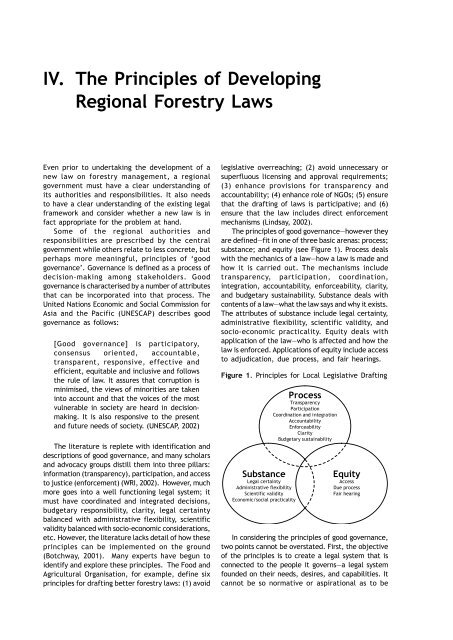A rough guide to developing laws for regional forest management
A rough guide to developing laws for regional forest management
A rough guide to developing laws for regional forest management
You also want an ePaper? Increase the reach of your titles
YUMPU automatically turns print PDFs into web optimized ePapers that Google loves.
IV. The Principles of Developing<br />
Regional Forestry Laws<br />
Even prior <strong>to</strong> undertaking the development of a<br />
new law on <strong>for</strong>estry <strong>management</strong>, a <strong>regional</strong><br />
government must have a clear understanding of<br />
its authorities and responsibilities. It also needs<br />
<strong>to</strong> have a clear understanding of the existing legal<br />
framework and consider whether a new law is in<br />
fact appropriate <strong>for</strong> the problem at hand.<br />
Some of the <strong>regional</strong> authorities and<br />
responsibilities are prescribed by the central<br />
government while others relate <strong>to</strong> less concrete, but<br />
perhaps more meaningful, principles of ‘good<br />
governance’. Governance is defined as a process of<br />
decision-making among stakeholders. Good<br />
governance is characterised by a number of attributes<br />
that can be incorporated in<strong>to</strong> that process. The<br />
United Nations Economic and Social Commission <strong>for</strong><br />
Asia and the Pacific (UNESCAP) describes good<br />
governance as follows:<br />
[Good governance] is participa<strong>to</strong>ry,<br />
consensus oriented, accountable,<br />
transparent, responsive, effective and<br />
efficient, equitable and inclusive and follows<br />
the rule of law. It assures that corruption is<br />
minimised, the views of minorities are taken<br />
in<strong>to</strong> account and that the voices of the most<br />
vulnerable in society are heard in decisionmaking.<br />
It is also responsive <strong>to</strong> the present<br />
and future needs of society. (UNESCAP, 2002)<br />
The literature is replete with identification and<br />
descriptions of good governance, and many scholars<br />
and advocacy groups distill them in<strong>to</strong> three pillars:<br />
in<strong>for</strong>mation (transparency), participation, and access<br />
<strong>to</strong> justice (en<strong>for</strong>cement) (WRI, 2002). However, much<br />
more goes in<strong>to</strong> a well functioning legal system; it<br />
must have coordinated and integrated decisions,<br />
budgetary responsibility, clarity, legal certainty<br />
balanced with administrative flexibility, scientific<br />
validity balanced with socio-economic considerations,<br />
etc. However, the literature lacks detail of how these<br />
principles can be implemented on the ground<br />
(Botchway, 2001). Many experts have begun <strong>to</strong><br />
identify and explore these principles. The Food and<br />
Agricultural Organisation, <strong>for</strong> example, define six<br />
principles <strong>for</strong> drafting better <strong>for</strong>estry <strong>laws</strong>: (1) avoid<br />
legislative overreaching; (2) avoid unnecessary or<br />
superfluous licensing and approval requirements;<br />
(3) enhance provisions <strong>for</strong> transparency and<br />
accountability; (4) enhance role of NGOs; (5) ensure<br />
that the drafting of <strong>laws</strong> is participative; and (6)<br />
ensure that the law includes direct en<strong>for</strong>cement<br />
mechanisms (Lindsay, 2002).<br />
The principles of good governance—however they<br />
are defined—fit in one of three basic arenas: process;<br />
substance; and equity (see Figure 1). Process deals<br />
with the mechanics of a law—how a law is made and<br />
how it is carried out. The mechanisms include<br />
transparency, participation, coordination,<br />
integration, accountability, en<strong>for</strong>ceability, clarity,<br />
and budgetary sustainability. Substance deals with<br />
contents of a law—what the law says and why it exists.<br />
The attributes of substance include legal certainty,<br />
administrative flexibility, scientific validity, and<br />
socio-economic practicality. Equity deals with<br />
application of the law—who is affected and how the<br />
law is en<strong>for</strong>ced. Applications of equity include access<br />
<strong>to</strong> adjudication, due process, and fair hearings.<br />
Figure 1. Principles <strong>for</strong> Local Legislative Drafting<br />
Substance<br />
Legal certainty<br />
Administrative flexibility<br />
Scientific validity<br />
Economic/social practicality<br />
Process<br />
Transparency<br />
Participation<br />
Coordination and integration<br />
Accountability<br />
En<strong>for</strong>ceability<br />
Clarity<br />
Budgetary sustainability<br />
Equity<br />
Access<br />
Due process<br />
Fair hearing<br />
In considering the principles of good governance,<br />
two points cannot be overstated. First, the objective<br />
of the principles is <strong>to</strong> create a legal system that is<br />
connected <strong>to</strong> the people it governs—a legal system<br />
founded on their needs, desires, and capabilities. It<br />
cannot be so normative or aspirational as <strong>to</strong> be

















